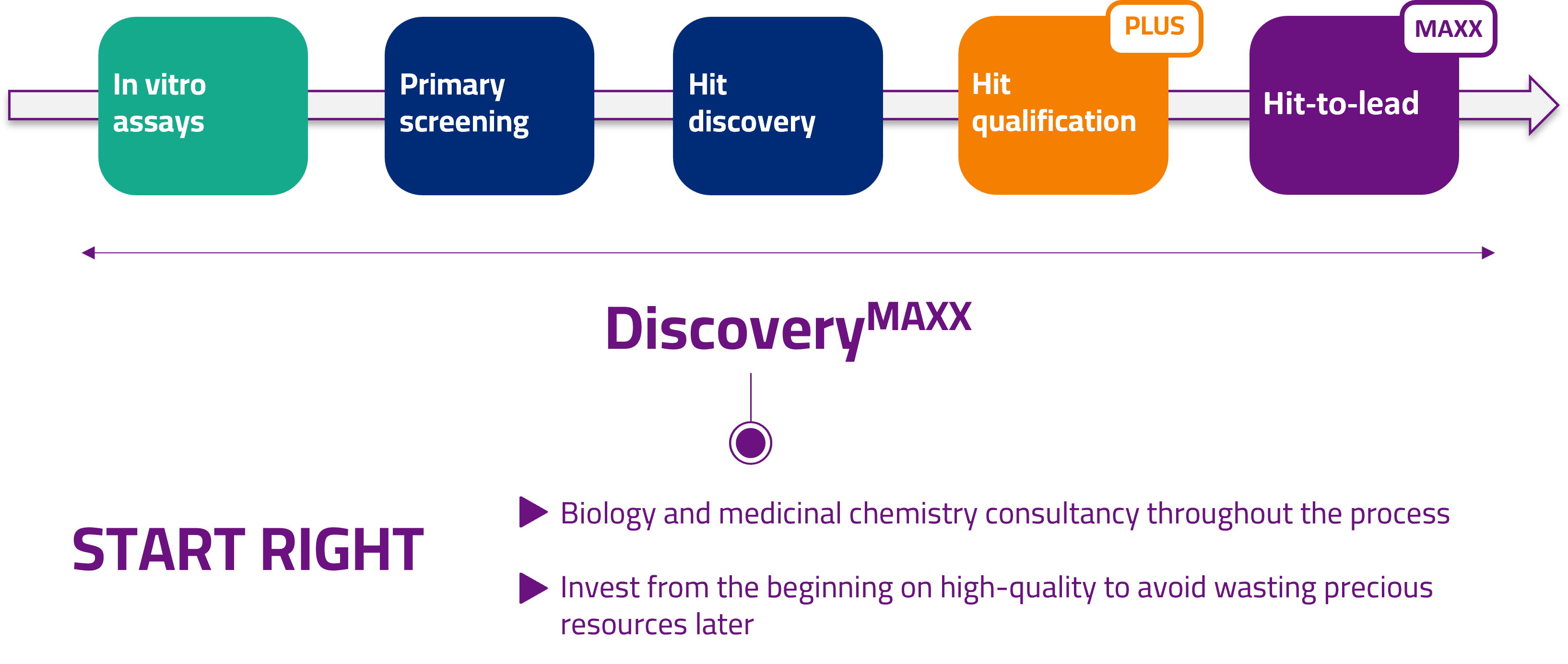Hit and Lead Identification at Axxam
Hit identification and hit-to-lead represent crucial early stages in the process of small molecule drug discovery. These stages set the groundwork for subsequent development efforts and significantly influence the trajectory of a drug candidate’s journey towards clinical application. The gradually increasing investments required to drive candidate compounds along the “R&D value chain” and the fact that large-scale discovery experiments in most cases are performed only once emphasize the relevance of these early project steps.
Building a strong hit and lead identification process not only prevents investing into the wrong compounds, but speeds up the progress by early selection of the right hits with the desired properties to deliver quality drug candidates. Hit identification is not a commodity. On the contrary: “starting your discovery project right” constitutes the best strategy to safeguard your investment.
At Axxam, we understand that the road to success in drug discovery is paved with challenges. Hence, our commitment to excellence begins with well-defined and meticulously planned screening and hit-to-lead processes. These processes seamlessly integrate the efforts of multidisciplinary teams, involving biologists, medicinal chemists, engineers, and data analysts and combining their diverse skills and know-how.

One of our central themes is the pursuit of quality. In our view, combining superior assay sensitivity with robust and reproducible test performance is key to identifying the most promising hit compounds to be promoted through the hit-to-lead phase.
DiscoveryMAXX - start right, progress faster
Axxam offers the possibility to run discovery programs all the way to compounds with a profile suitable for the in vivo proof-of-concept in relevant animal models. The DiscoveryMAXX package is a comprehensive program that seamlessly continues from assay development through high-throughput screening (HTS) and hit qualification to hit-to-lead optimization.
Hit compounds can be optimized towards an agreed target product profile by combining expert medicinal chemistry with our in vitro biology and pharmacology platforms, as well as other required capabilities in-sourced from trusted partners, for individual project needs, such as in vivo DMPK. Depending on the target of interest and available data on either target or ligand structure(s), the process will also be supported by computational chemistry.

DiscoveryMAXX provides clients with the opportunity to have a single partner driving and coordinating their discovery project from target selection to the generation of a small molecule lead candidate for in vivo testing. Thus DiscoveryMAXX completes our ambition to translate innovative biology into quality chemistry.
Obtain qualified hits through HTSPLUS
As mentioned, HTS is an important step in a drug discovery program, nevertheless it is the exception that hit lists obtained from HTS readily reveal compounds ideal for further prosecution. This is because many aspects other than the potency of a screening hit will impact downstream success. In most cases, additional information is required to fully appreciate the data and to select hit compounds for optimization.
The substantial time and resource investments of optimization activities render this early selection process critical to the timely progression and ultimate success of a discovery program. Building on our past experience in numerous screening projects, we offer to our clients the HTSPLUS package that includes a thorough hit qualification from both, the biological and chemistry perspectives to support our clients in the task of making sense out of HTS hit lists derived from screening the Axxam compound collection AXXDiversity.

The key to hit qualification within the HTSPLUS is the quick expansion of the knowledge around the most promising hit compounds delivered by HTS. Activities to further qualify hits will include the resynthesis of hit compounds, analoging via catalogue and/or synthesis of ‘strategic analogues’, together with the quantitive assessment of basic compound properties related to their physicochemical and most basic ADME properties. It also includes the rigorous testing of specificity, selectivity (potentially including orthologues) and mode-of-action (MoA) of all newly generated compounds. Results will confirm the structural identity of the hit compounds, further consolidate the target specificity and desired MoA, and provide initial insights into emerging features of the underlying structure-activity relationship and compound property profiles. An initial check of the small molecule intellectual property landscape around hit compounds completes the package. All data together will allow a well-informed hit selection process to ensure placing downstream investments on the right candidates emerging from the qualification process.

